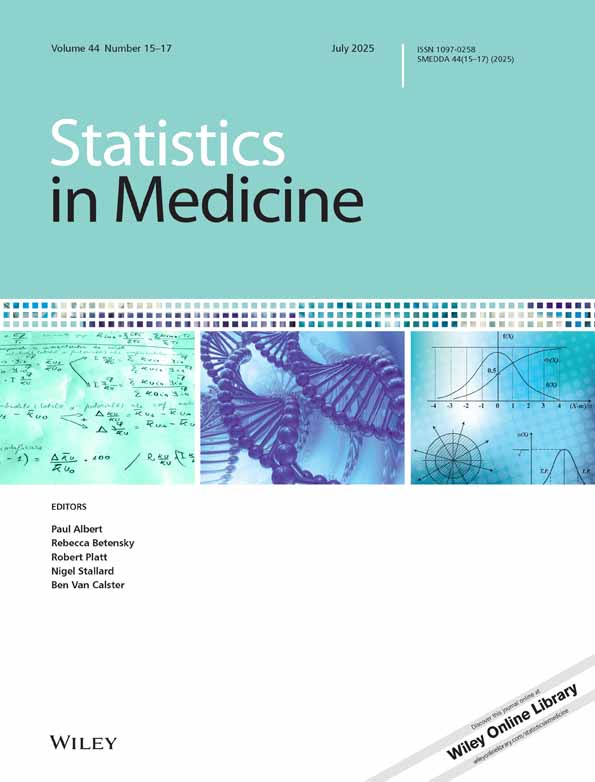Statistical issues in bioequivalance
Corresponding Author
Stephen Senn
Department of Epidemiology and Public Health, Department of Statistical Science, University College London, Gower Street, London, U.K.
Department of Epidemiology and Public Health, Department of Statistical Science, University College London, Gower Street, London WC1E 6BT, U.K.Search for more papers by this authorCorresponding Author
Stephen Senn
Department of Epidemiology and Public Health, Department of Statistical Science, University College London, Gower Street, London, U.K.
Department of Epidemiology and Public Health, Department of Statistical Science, University College London, Gower Street, London WC1E 6BT, U.K.Search for more papers by this authorAbstract
There has been much work recently on individual bioequivalence and the topic has attracted considerable controversy. Some previous controversies regarding average bioequivalence are examined. It is argued that a contributory factor in these controversies may have been confusion over the purpose of bioequivalence trials. It is concluded that this purpose needs further clarification before guidelines for individual bioequivalence can be established and indeed that such guidelines may turn out to be unnecessary. Copyright © 2001 John Wiley & Sons, Ltd.
REFERENCES
- 1 Winslade J, Hutchinson DR. Dictionary of Clinical Research. Brookwood Medical Publications: Brookwood, 1992.
- 2 Senn SJ, Lillienthal J, Patalano F, Till D. An incomplete blocks cross-over in asthma: a case study in collaboration. In Cross-over Clinical Trials, J Vollmar, L Hothorn. (eds). Fischer: Stuttgart, 1997; 3–26.
- 3 Senn SJ. Statistical Issues in Drug Development. Wiley: Chichester, 1997.
- 4 Steinijans VW, Hauschke D. International harmonization of regulatory bioequivalence requirements. Clinical Research and Regulatory Affairs 1993; 10: 203–220.
10.3109/10601339309079568 Google Scholar
- 5 Hauschke D, Steinijans VW. Cross-over trials for bioequivalence assessment. In Cross-over Clinical Trials. J Vollmar, L Hothorn (eds). Fischer: Stuttgart, 1997; 27–40.
- 6 Senn SJ. Cross-over Trials in Clinical Research. Wiley: Chichester, 1993.
- 7 Westlake WJ. The use of confidence intervals in comparative bioavailability trials. Journal of Pharmaceutical Sciences 1972; 61: 1340–1341.
- 8 Westlake WJ. Symmetrical confidence intervals for bioequivalence trials. Biometrics 1976; 32: 741–744.
- 9 O'Quigley J, Baudoin C. General approaches to the problem of bioequivalence. Statistician 1988; 37: 51–58.
- 10 Kirkwood TBL. Bioequivalence testing—a need to rethink. Biometrics 1981; 37: 589–591.
- 11 Armitage P. Editorial note. Biometrics 1981; 37: 593–594.
- 12 Schuirmann DJ. A comparison of two one-sided tests procedure and the power approach for assessing the equivalence of average bioavailability. Journal of Pharmacokinetics and Biopharmaceutics 1987; 15: 657–680.
- 13 Mehring GH. On optimal tests for general interval-hypotheses. Communications in Statistics – Theory and Methods 1993; 22: 1257–1297.
- 14 Karlin S. Decision theory for Pólya type distributions. Case of two actions 1. Third Berkeley Symposium on Probability and Statistics 1956; 1: 115–129.
- 15 Anderson S, Hauck WW. A new procedure for testing equivalence in comparative bioavailability and other clinical trials. Communications in Statistics, A 1983; 12: 2663–2692.
- 16 Berger R, Hsu J. Bioequivalence trials, intersection-union tests, and equivalence confidence sets. Statistical Science 1996; 11: 283–319.
- 17 Brown LD, Hwang JTG, Munk A. An unbiased test for the bioequivalence problem. Annals of Statistics 1997; 25: 2345–2367.
- 18 Lindley DV. Decision analysis and bioequivalence trials. Statistical Science 1998; 13: 136–141.
- 19 Anderson S, Hauck WW. Consideration of individual bioequivalence. Journal of Pharmacokinetics and Biopharmaceutics 1990; 18: 259–273.
- 20 Senn SJ. In the blood: proposed new requirements for registering generic drugs. Lancet 1998; 352: 85–86.
- 21 Centre for Drug Evaluation and Research. Guidance for Industry: Average, Population, and Individual Approaches to Establishing Bioequivalence. US. Department of Health and Human Services Food and Drug Administration, 1999.
- 22 Hauck WW. Chen ML, Hyslop T, Patnaik R, Schuirmann D, Williams R. Mean difference vs. variability reduction: tradeoffs in aggregate measures for individual bioequivalence. FDA Individual bioequivalence group. International Journal of Clinical Pharmacology and Therapeutics 1996; 34: 535–541.
- 23 Patnaik RN, Lesko LJ, Chen ML, Williams RL. Individual bioequivalence. New concepts in the statistical assessment of bioequivalence metrics. FDA Individual bioequivalence working group. Clinical Pharmacokinetics 1997; 33: 1–6.
- 24 Schall R, Williams RL. Towards a practical strategy for assessing individual bioequivalence. Food and Drug Administration individual bioequivalence working group. Journal of Pharmacokinetics and Biopharmaceutics 1996; 24: 133–149.
- 25 Grieve AP. Joint equivalence of means and variances of two populations. Journal of Biopharmaceutical Statistics 1998; 8: 377–390.
- 26 Anderson GP. Formoterol: pharmacology, molecular basis of agonism, and mechanism of long duration of a highly potent and selective beta 2-adrenoceptor agonist bronchodilator. Life Sciences 1993; 52: 2145–2160.
- 27 Selroos O. The pharmacologic and clinical properties of Oxis (formoterol) Turbuhaler. Allergy 1998; 53(42 Suppl): 14–19.
- 28 Shumaker RC, Metzler CM. The phenytoin trial is a case study of ‘individual’ bioequivalence. Drug Information Journal 1998; 32: 1063–1072.
Citing Literature
Special Issue:Statistical Issues in Biopharmaceutical Environments: Towards the Next Millennium
15 ‐ 30 September 2001
Pages 2785-2799




